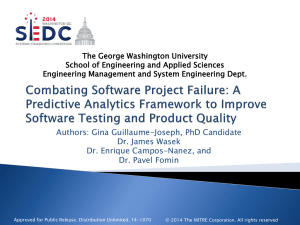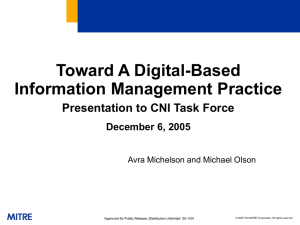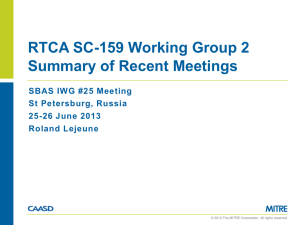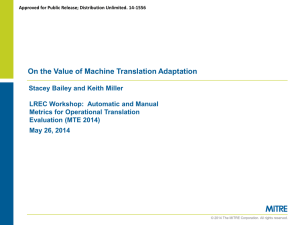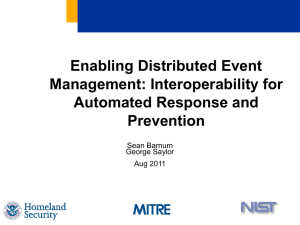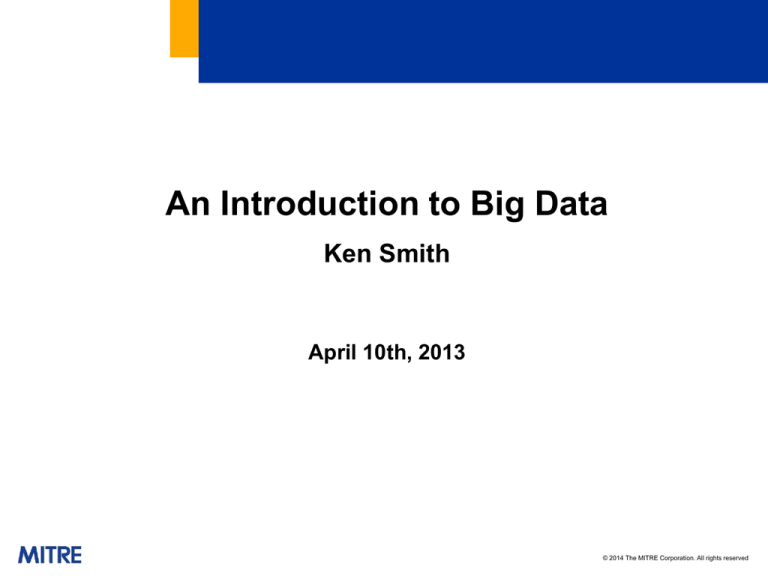
An Introduction to Big Data
Ken Smith
April 10th, 2013
© 2014 The MITRE Corporation. All rights reserved
Big Data …
Its Technologies & Analytic Ecosystem
For Internal MITRE Use
© 2013 The MITRE Corporation. All rights reserved
Course Goal
Hype
curve
………….Tethered To Reality…….......
3
© 2012 The MITRE Corporation. All rights reserved
Outline
Background: What is “Big Data”? … Why is it big?
Parallel Technologies for Big Data Problems
Big Data Ecosystem
Ongoing Challenges
4
© 2012 The MITRE Corporation. All rights reserved
What is “Big Data”?
O’Reilly:
– “Big data is when the size of the data itself becomes part of the
problem”
EMC/IDC:
– “Big data technologies describe a new generation of
technologies and architectures, designed to economically
extract value from very large volumes of a wide variety of data,
by enabling high-velocity capture, discovery, and/or analysis.”
IBM: (The famous 3-V’s definition)
– Volume (Gigabytes -> Exabytes)
– Velocity (Batch -> Streaming Data)
– Variety (Structured, Semi-structured, & Unstructured)
Credit: Big Data Now, Current Perspectives from O’Reilly Radar (O’Reilly definition); Extracting Value from Chaos, Gantz et al. (IDC definition);
Understanding Big Data, Eaton et al. (IBM definition)
5
© 2012 The MITRE Corporation. All rights reserved
Data Size Terminology
© 2012 The MITRE Corporation. All rights reserved
A Simple Data Structure Taxonomy
Structured data
– Data adheres to a strict template/schema
– spreadsheets, relational databases, sensor feeds, …
Semi-structured data
– Data adheres to a flexible (grammar-based) format
Optional fields, repeating fields
– Web pages / forms, documents, XML, JSON, …
Unstructured data
– Data adheres to an unknown format
No schema or grammar; you discover what each byte is
and means by examining the data
– Unparsed text, raw disks, raw video & images, …
“Variety”: constantly coping with structure
variations; multiple types; changing types
7
© 2012 The MITRE Corporation. All rights reserved
Why Are Volume & Velocity Increasing?
1) Internet-Scale Datasets
–
–
–
–
Activity logfiles (e.g., clickstreams, network logs)
Internet indices
Relationship data / social networks
Velocity note: Bin Laden’s death resulted in
5106 tweets/second
8
© 2012 The MITRE Corporation. All rights reserved
Why Are Volume & Velocity Increasing?
2) Sensor Proliferation
– Weather satellites; flight recorders; GPS feeds; medical and
scientific instruments; cameras
– Government agencies who want a sensor on every potentially mad
cow, in every cave in Afghanistan, on every cargo container, etc.
What if their wish is granted?
– Velocity notes:
Large Hadron Collider generates 40T/sec
High Def UAVs that collect 1.4P/mission
– Variety note: increasing # of sensor feeds increasing variety
9
© 2012 The MITRE Corporation. All rights reserved
Why Are Volume & Velocity Increasing?
3) Because, with modern cloud parallelism, you can ….
– Problem: “Frequent close encounters” are suspicious
Given: 73,241 ships reporting {id, lat, long} every 5 minutes for 2 weeks
Resulting dataset = 15 GB (uncompressed and indexed)
– How do you detect all pairs of ships within X meters of each other?
Many solutions generate intermediate “big data”
10
© 2012 The MITRE Corporation. All rights reserved
What Good is Big Data? Some Examples!
1) As a basis for analysis
– As a human behavior sensor
– Supporting new approaches to science
2) To create a useful service
11
© 2013 The MITRE Corporation. All rights reserved
Outline
Background: What is “Big Data”? … Why is it big?
Parallel Technologies for Big Data Problems
Big Data Ecosystem
Ongoing Challenges
12
© 2012 The MITRE Corporation. All rights reserved
Traditional Scaling “Up”: Improve The
Components of One System
OS: multiple threads / VMs
CPU: increase clock speed,
bus speed, cache size
RAM: increase capacity
Disk: Increase capacity,
decrease seek time, RAID
13
© 2012 The MITRE Corporation. All rights reserved
Scaling “Out”: From Component Speedup to
Aggregation
Multicore cores on a chip (2, 4, 6, 8, ....)
14
© 2012 The MITRE Corporation. All rights reserved
From Component Speedup to Aggregation
Multiserver Racks (“Shared Nothing” – only interconnect)
15
© 2012 The MITRE Corporation. All rights reserved
From Component Speedup to Aggregation
Multi-Rack Data Centers
© 2012 The MITRE Corporation. All rights reserved
16
From Component Speedup to Aggregation
If you are Google or a few others:
Multiple Data Centers
17
© 2012 The MITRE Corporation. All rights reserved
The Resulting “Computer” & Its Applications
OS
CPU
RAM
......
Disk
This massively parallel architecture can be treated as a
single computer
Applications for this “computer”:
– Can exploit computational parallelism (near linear speedup)
– Can have a vastly larger effective address space
– Google and Facebook field applications whose user base is
measured as a reasonable fraction of the human race
© 2012 The MITRE Corporation. All rights reserved
18
The Power of Parallelism: Divide & Conquer
“Work”
Partition
w1
w2
w3
“worker”
“worker”
“worker”
r1
r2
r3
“Result”
Combine
Page 3.8
Source: a slide by Jimmy Lin, cc-licensed
© 2012 The MITRE Corporation. All rights reserved
Some Important Software Realities In a
Massively Parallel Architecture
Communication costs
Fault-tolerance
Programming abstractions
20
© 2012 The MITRE Corporation. All rights reserved
“Numbers Everyone Should Know”
From SoCC 2010 Keynote – Jeffrey Dean, Google
L1 cache reference
Branch mispredict
L2 cache reference
Mutex lock/unlock
Main memory reference
Compress 1K w/cheap algorithm
Send 2K bytes over 1 Gbps network
Read 1 MB sequentially from memory
Round trip with same datacenter
Disk seek
Read 1 MB sequentially from disk
Send packet CA->Netherlands->CA
0.5 ns
5 ns
7 ns
25 ns
100 ns
3,000 ns
20,000 ns
250,000 ns
500,000 ns
10,000,000 ns
20,000,000 ns
150,000,000 ns
21
© 2012 The MITRE Corporation. All rights reserved
Some Important Software Realities In a
Massively Parallel Architecture
Communication costs
Fault-tolerance
Programming abstractions
22
© 2012 The MITRE Corporation. All rights reserved
Fault Tolerance
Frequency of faults in massively parallel architectures:
– Google reports an average of 1.2 failures per analysis job
– We assume our laptop will last through the week; but you lose
this when you compute with 1000’s of commodity machines.
What if the result waits because 499 / 500 worker tasks have
completed
– but #500 never will finish:
Strategy:
– Redundancy and checkpointing
23
© 2012 The MITRE Corporation. All rights reserved
Some Important Software Realities In a
Massively Parallel Architecture
Communication costs
Fault-tolerance
Programming abstractions
24
© 2012 The MITRE Corporation. All rights reserved
How Do You Program A Massively
Parallel Computer?
Parallel programming without help can be very painful!
– Parallelize: translate your application into a set of parallel tasks
– Task management: assigning tasks to processors, inter-task
communication, task restart when they crash
– Task synchronization: avoiding extended waits and deadlocks
Programmers need simplifying abstractions to be productive
– Pioneers Google & Facebook were forced to invent these
– Hadoop now provides a tremendous suite
Analogy: RDBMSs provide the atomic transaction abstraction
– no programmer wants to worry about the details who is reading &
writing data while they do!
– Just use “begin transaction” and “end transaction” to insulate
your code from others using the system
25
© 2012 The MITRE Corporation. All rights reserved
Apache Hadoop
Open source framework for developing & running parallel applications
on hardware clusters
– Cloudera & Hortonworks sell “premium” versions & support
– adapted from Google’s internal programming model
– available at: hadoop.apache.org
Key components:
–
–
–
–
–
HDFS (Hadoop Distributed File System)
Map-Reduce (parallel programming pattern)
Hive, Pig (higher-level languages which compile into Map-Reduce)
HBase (key-value store)
Mahout (data mining library)
Some non-Hadoop parallel frameworks also exist:
– Asterdata & Greenplum sell {RDBMS + Map-Reduce + analytics}
26
© 2012 The MITRE Corporation. All rights reserved
HDFS (Hadoop Distributed File System)
Reduce
Map
HDFS files
..
Underlying
file system
files
....
HDFS:
– provides a single unified file system
abstracting away the many underlying machines’ file systems
– load balances file fragments, maintains replication levels
© 2012 The MITRE Corporation. All rights reserved
27
HDFS (Hadoop Distributed File System)
HDFS components:
–
–
–
–
NameNode manages overall file system metadata
DataNodes (one per machine) manage actual data
DataNodes are easy to add, expanding the file system
Both DataNode and NameNodes include a webserver, so node
status can be easily checked
Example commands:
– “/bin/hdfs dfs –ls”
lists files in an HDFS directory
corresponds to linux “ls”
– “/bin/hdfs dfs -rm xx”
removes HDFS file xx
corresponds to linux “rm xx”
© 2012 The MITRE Corporation. All rights reserved
28
HDFS Architecture
Adapted from (Ghemawat et al., SOSP 2003)
Page 21
© 2012 The MITRE Corporation. All rights reserved
MapReduce
■ Iterate over a large number of records
■ Extract something of interest from each
■ Shuffle and sort intermediate results
■ Aggregate intermediate results
■ Generate final output
Build a
sequence
of MR
steps
Key idea: provide a functional abstraction for
these two operations
Page 3.7
© 2012 The MITRE Corporation. All rights reserved
Ideal MapReducable Problems
1) Input data can be naturally split into “chunks” and distributed
2) Large amounts of data
– If smaller than HDFS block size, don’t bother
3) Data independence
– Ideally, map operation does not depend on data at other nodes
4) Good redistribution key exists
– Output of map job is key-value pairs
– The key is used to shuffle/sort the output to the reducers
Example: build a word-count index for a huge document corpus
– Map: emit {docid, word, 1} tuple for each occurence
– Reduce: sum similar tuples, like: {“War And Peace”, *, 1}
Not all problems are “ideal”, but MR can still work: www.adjointfunctors.net/su/web/354/references/graph-processing-w-mapreduce.pdf
Page 3.9
© 2012 The MITRE Corporation. All rights reserved
MapReduce/HDFS Architecture
From Wikipedia Commons: http://en.wikipedia.org/wiki/File:Hadoop_1.png
Page 21
© 2012 The MITRE Corporation. All rights reserved
Higher Level Languages: Hive
Hive is a system for managing and querying structured
data
– Used extensively to provide SQL-like functionality:
– Compiles into map-reduce jobs
– Includes an optimizer*
Developed by Facebook
– Almost 99.9% Hadoop jobs at Facebook are generated by
a Hive front-end system.
*Hive optimizations at: citeseerx.ist.psu.edu/viewdoc/download?doi=10.1.1.151.2637
Page 25
© 2012 The MITRE Corporation. All rights reserved
Apache Pig
Open source scripting language
– Provides SQL-like primitives in a scripting language
– Developed by Yahoo! Almost 30% of their analytic jobs are
written in “Pig Latin”
Execution Model
– compiles into MapReduce (over HDFS files, HBase tables)
– Approximately 30% overhead
– Optimizes multi-query scripts, filter and limit optimizations that
reduce the size of intermediate results
Example commands
– FILTER: hour00 = FILTER hour_frequency2 BY hour eq '00';
– ORDER: ordered_uniq_frequency = ORDER filtered_uniq_frequency BY (hour, score);
– GROUP: hour_frequency1 = GROUP ngramed2 BY (ngram, hour);
– COUNT: hour_frequency2 = FOREACH hour_frequency1 GENERATE flatten($0), COUNT($1) as
count;
Page 26
© 2012 The MITRE Corporation. All rights reserved
The Human Approach
Massively parallel human beings
– “crowdsourcing”
A good list of projects:
– en.wikipedia.org/wiki/List_of_crowdsou
rcing_projects
35
© 2012 The MITRE Corporation. All rights reserved
Outline
Background: What is “Big Data”? … Why is it big?
Parallel Technologies for Big Data Problems
Big Data “Ecosystems”
Ongoing Challenges in Big Data Ecosystems
36
© 2012 The MITRE Corporation. All rights reserved
General “Funnel” Model of Big Data
Analytic Workflows
1) Ingest of diverse
raw data sources:
text, sensor feeds,
semi-structured (e.g.,
web content, email)
3) Generate more
structured datasets as
needed: RDBMS tables,
objects, triple stores
4) Generate & explore userfacing analytic models (data
cubes, graphs, clusters).
Drill down to details.
2) Transform, clean,
subset integrate,
index, new datasets.
Enrich: extract
entities, compute
features & metrics.
Data science teams work
across entire spectrum
Some examples & technology stacks:
–
Clickstream analysis; stock “tick” analysis; social network analysis
–
Google’s Tenzing stack: SQL/OLAP over Hadoop
–
Cloudera’s stack: Hive/Pig compiling into Hadoop
–
Greenplum’s stack: SQL compiling directly onto servers, OR into
MapReduce via “external tables”
© 2012 The MITRE Corporation. All rights reserved
Ecosystem Overview
A frequent workflow is emerging:
–
–
–
–
1) Ingest data from diverse sources
2) ETL / enrichment
3) Intermediate data management
4) Refined data management (graphs, parsed triples from text,
OLAP/relational data)
– 5) Analytics & viz tools to build/test models, support decisions
– 6) Reachback into earlier steps by “data scientists”
Common to diverse types of organizations:
– marketing, financial research, scientists, intelligence agencies, …
– (social media providers are a bit different: they host the big data)
Many technologies working together
– Map reduce, semistructured (“NoSQL”) databases, graph databases,
RDBMSs, machine learning/data mining algorithms, analytic tools,
visualization techniques
We will touch on some of these through the rest of today
– Many are new and evolving; this is a rapidly moving train!
38
© 2012 The MITRE Corporation. All rights reserved
Emergence of the Data Scientist
Page 8.5
© 2012 The MITRE Corporation. All rights reserved
Spectrum of Big Data Ecosystem Classes
Big Data Ecosystems differ along several key questions:
1) Is there a hypothesis being tested?
– Testing a hypothesis requires a more sophisticated analysis process
2) Is external data being gathered?
– Versus all internally generated data.
– External data requires more ETL effort
3) Does it make sense to evolve and expand this ecosystem?
– The greater the up-front investment, the more important it is to address
serendipitous new hypotheses by reusing/augmenting existing data
resources
40
© 2012 The MITRE Corporation. All rights reserved
Spectrum of Big Data Ecosystem Classes
1) Non-experiment (no hypothesis exists, external data)
–
–
–
–
No hypothesis or learning experiment
Ecosystem reports aspects of external data, little analysis / new truth
Example: CNN “trending now” alerts
(Note: subject to being “gamed” by manipulation of external data!)
2) Evolving experimental ecosystem (hypotheses & external data)
3) Self contained experiment (hypothesis exists, no external data)
41
© 2012 The MITRE Corporation. All rights reserved
The Non-Experiment
(Example: “Trending Now”)
1) External
data ingested
2) Basic processing applied to
“add value” for consumers (but
no rigorous model learning, or
hypothesis testing)
© 2012 The MITRE Corporation. All rights reserved
A Spectrum of Big Data Ecosystems
1) Non-experiment
2) Evolving experimental ecosystem (hypotheses, external data)
3) Self-contained experiment (a hypothesis exists, no external data)
– Pre-existent (scientific) hypothesis to test
– All necessary data generated to spec within the ecosystem
– Example: Argonne National Labs
43
© 2012 The MITRE Corporation. All rights reserved
The Self-Contained Experiment
(Example: Argonne National Labs)
1) A scientific hypothesis H
exists, and a plan to test H by
analyzing large datasets.
Valid
4) Plan / model
applied to data
to validate/
invalidate H
2) Any data
needed to test
H is generated
“internally”
3) Data analysis. Perhaps
requiring a predictive model
to be learned & refined
Not valid
© 2012 The MITRE Corporation. All rights reserved
Spectrum of Big Data Ecosystem Classes
1) Non-experiment (no hypothesis exists, external data)
2) Evolving experimental ecosystem (potential hypotheses, external
data)
–
–
–
–
Massive external datasets suggest new insights / competitive advantage
Hypothesis formed and external data gathered
Experiment / ecosystem designed to test hypothesis, provide insight
Once in place, ecosystem is reused & evolves:
new data & hypotheses, cost amortized
– Sweet spot … (Consumer analysis, Intelligence analysis …)
3) Self-contained experiment
45
© 2012 The MITRE Corporation. All rights reserved
Evolving Experiment Ecosystem: E3
(Example: Google Adwords)
1) Massive external data
suggests new insights /
competitive advantages
1b) Incremental data
suggests incremental
insights …
Valid
Valid
4) Plan / model
applied to data
to validate/
invalidate H
2) Initial
hypothesis H
formed & data
gathered to test
it.
Not valid
Not valid
3) Data analysis. Perhaps
requiring a predictive model
to be learned & refined
© 2012 The MITRE Corporation. All rights reserved
Questions?
47
© 2012 The MITRE Corporation. All rights reserved
Outline
Background: What is “Big Data”? … Why is it big?
Parallel Technologies for Big Data Problems
Big Data “Ecosystems”
Ongoing Challenges in Big Data Ecosystems
48
© 2012 The MITRE Corporation. All rights reserved
Some General & Ongoing Challenges
Ecosystems are mature to the extent that they work now.
But definitely not a fully “solved problem”!!
Some outstanding issues to keep an eye on:
– Sampling
What if two sources are sampled differently?
– Security
– Privacy
– Metadata
E.g., How do we deal with evolution of processing?
– Moving/loading big data
– People
finding, retaining, assigning to roles, training/growing, paying
– Outsourcing options
disk growth beyond your budget, need for services you can’t provide
49
© 2012 The MITRE Corporation. All rights reserved
Normal “Funnel” Model of Big Data
Analytic Workflows
- Assumption that all data “melts
together” within the funnel
© 2012 The MITRE Corporation. All rights reserved
Security-Partitioned “Funnel” Model of Big
Data Analytic Workflows
- Assumption that certain data must
not be mixed …
- How do you implement separation?
- Issues: What does this mean for
the ability to aggregate, infer?
© 2012 The MITRE Corporation. All rights reserved
Other Security Issues
Parallel HW is often managed by 3rd parties for economics:
– Should I expose my sensitive data to DBAs who don’t work for me?
– What about other unknown/untrusted tenants of a rented HW
infrastructure?
Standard encryption only addresses data at rest
– When a query hits the DBMS it becomes plaintext in RAM. A rouge
cloud DBA can see all my “encrypted” data.
It’s hard to map high level policies onto detailed implementations,
big data makes this worse
– E.g., Books about the stock market cannot be checked out to freshmen
52
© 2012 The MITRE Corporation. All rights reserved
Accumulo Data Sensitivity Labels
Key
Row ID
Column
Family
Qualifier
Visibility
Timestamp
Value
Label definition
– Labels (e.g., SECRET, NOFORN) are defined, applied on ingest
– Cryptographically bound to data
– Applied at the key-level (i.e., to every value individually)
See: accumulo.apache.org/1.4/user_manual/Security.html
Access:
– Database users obtain are assigned labels; these are used to
gain access when a user authenticates as that user.
Issues to consider:
– Admin overhead of defining and applying labels to every value
– Aligning heterogeneous label sets to realize possible sharing
– Label assurance
Page 3.4
© 2012 The MITRE Corporation. All rights reserved
Lack of Metadata As Harmful:
54
© 2012 The MITRE Corporation. All rights reserved
Metadata Challenges in Sponsor Ecosystems
1) Exploiting myriads of datasets with agility
– What columns link voice recordings to radar? When do they
simultaneously exist in this table? Where are temperature readings?
2) Dealing with “shape-changing” data sources
– When data format continually changes, how does my reader interpret
serialized data instances without schema information?
3) Accurately matching analytics to datasets
– Analytic A requires column C1, derived by f8(). Does C1 exist for May? If C1
exists, but was derived from f7(), it would be bad if A “fails silently”!
4) Rapidly incorporating unknown data sources
– Can I reuse the ingest & transformation code from other data sources?
5) Reasoning about the data (data scientist needs)
– Where are value distributions & trends over time (e.g., to test a hypothesis,
to infer semantics, for process optimization)…
Theme: Poorly understood datasets result
in high overhead & degraded analytics
55
© 2012 The MITRE Corporation. All rights reserved
More Use Cases For Metadata
Our Big Data sponsors are obligated to know:
What data should be retained?
– Given the size of the data, all information can’t be retained forever. Decisions are currently
made ‘off the cuff’ which data to retain, and which to let go. Can we characterize data’s use to
support retention decisions?
Where did this data come from?
– Analysts are writing reports and need to know the source of the data so they can determine
trustworthiness, legality, dissemination restrictions, and potentially reference the original
data object
Where a class of data resides?
– This is largely a compliance and auditing function. A redacted use case would be: “Which of
my systems currently house PII data? Do any systems house this data that aren’t approved
for it? Are my security controls working?” With an increasing reliance on both public and
private clouds, this is growing increasingly challenging.
Where a specific data item resides?
– If the lawyers call and say I need to get rid of a certain piece of intelligence, can I locate all
copies of it? Who else did I sent it to? If there is a breach at a cloud provider or partner, do I
know what data items landed within their perimeter? This would enable more granular breach
notifications.
Page 56
© 2012 The MITRE Corporation. All rights reserved
What is Provenance?
“Family Tree” of relationships
– Ovals = data, rectangles =
processes
– Show how data is used and
reused
Basic metadata
– Timestamp
– Owner
– Name/Descr
Can also include annotations
– E.g. quality info
Is not the actual data object
Page 57
© 2012 The MITRE Corporation. All rights reserved
How is it Done Today?
The general approach is: “The developers just kinda know.”
– This does not scale! (with variety … the under-served “V”)
Some large companies are now developing point solutions, as
vast #’s of different data formats accumulate:
– Protobuf schema repository from Google
– Avro schema repository from LinkedIn
– Hive metacatalog (basis of hCatalog)
■ But these are not general & powerful “first principles”
solutions
Format-specific data model (e.g., hCatalog favors Hive)
Typically focus only on the “SeDe” issue
– “poor man’s metadata repository”
– https://issues.apache.org/jira/si/jira.issueviews:issue-html/AVRO-1124/AVRO-1124.html
58
© 2012 The MITRE Corporation. All rights reserved
Questions?
59
© 2012 The MITRE Corporation. All rights reserved
Next Topic in the Outline
Intro to Big Data and Scalable Databases
– Part 1: Big Data… Its Technologies & Analytic Ecosystem
– Part 2: An Introduction To Parallel Databases
– Part 3: Technological Innovations and MPP RDBMS
60
© 2012 The MITRE Corporation. All rights reserved
An Introduction To
Parallel
Databases
Parallel
Databases
Parallel
ParallelDatabases
Databases
For Internal MITRE Use
© 2012 The MITRE Corporation. All rights reserved
Purpose of This Talk
Let’s say you have a problem involving:
and
Lots of data
can apply multiple
processors
What can a database do for me?
What databases are available? How do I pick?
62
© 2012 The MITRE Corporation. All rights reserved
Outline
Taxonomy
Software realities for parallel databases
Systems engineering strategies
63
© 2012 The MITRE Corporation. All rights reserved
A Simple Taxonomy of Parallel Databases
“Clouds” are increasingly attractive computational platforms
– Traditional solutions don’t automatically scale well to clouds,
innovation is occuring rapidly ...
A Lot!
BigTable / Hbase /
Accumulo
Non-relational
100
0
Aster Data
Max Number
of Processors
MongoDB
FlockDB
(aka NoSQL)
Greenplum
100
Parallel
Relational
10
Traditional
RDBMS
1
Structured Semi-structured
Triples,
Relational (e.g., “Document- Key-value
oriented)
Market Trends
– Consolidation
– Hybrids
– To “upper left”
64
Data Model Structure
© 2012 The MITRE Corporation. All rights reserved
A More Complex Taxonomy (451 group)
Oh My!
65
© 2012 The MITRE Corporation. All rights reserved
Taxonomy Used In This Talk
Key-value stores
Semi-structured databases
Parallel relational
Graph databases & Triplestores
66
© 2012 The MITRE Corporation. All rights reserved
A Short History of Key Value Stores
2004: Google invented BigTable
– Now being replaced by Spanner (distributed transactions, SQL)
2007: Hbase (open source BigTable): hbase.apache.org
– Large & growing user community; HDFS file system
2008: Facebook invents Cassandra
– HBase data model, but P2P file system; released open source
2010: Facebook enhances & adopts HBase internally
2011: NSA releases Accumulo open source: accumulo.apache.org
– Similar to Hbase; includes data sensitivity labels
2012: Basho releases Riak: wiki.basho.com
– Web friendly; based on Amazon’s dynamo paper
67
© 2012 The MITRE Corporation. All rights reserved
Key-Value Store Data Model
Datasets typically modeled as one very large table
Key: <row id, column id, version>
– Row id (canonical Google row id: reversed URL)
– Column id
static number of carefully designed column “families”
each family can have an unbounded number of columns
– Version-timestamp
Database keeps record of all previous values (update = append)
Query examples:
– given a full key, return the value
– given a column ID and a value, return all matching rows
68
© 2012 The MITRE Corporation. All rights reserved
Other Characteristics of Key Value Stores
Performance: designed for scale out
– 1 index on the key (faster than HDFS scan), no optimizer
Cost: Typically open source; need Hadoop / programming skills
– Cloudera support is ~$4K/node
Roles:
– Great fit: for data you don’t understand well yet (e.g., ETL)
Massive, rapidly arriving, highly non-homogenous datasets
Need for query by key; enriching by adding aribtrary columns
– Poor fit: if you know exactly what your data looks like (lose schema)
© 2012 The MITRE Corporation. All rights reserved
69
HBase Table Creation Example
Create a table named test with a single column family named cf.
Verify its creation by listing all tables and then insert some values.
hbase(main):003:0> create 'test', 'cf'
0 row(s) in 1.2200 seconds
hbase(main):003:0> list 'test'
..
1 row(s) in 0.0550 seconds
hbase(main):004:0> put 'test', 'row1', 'cf:a', 'value1'
0 row(s) in 0.0560 seconds
hbase(main):005:0> put 'test', 'row2', 'cf:b', 'value2'
0 row(s) in 0.0370 seconds
hbase(main):006:0> put 'test', 'row3', 'cf:c', 'value3'
0 row(s) in 0.0450 seconds
70
© 2012 The MITRE Corporation. All rights reserved
HBase Example
Verify the data insert by running a scan of the table:
hbase(main):007:0> scan 'test'
ROW
COLUMN+CELL
row1
column=cf:a, timestamp=1288380727188, value=value1
row2
column=cf:b, timestamp=1288380738440, value=value2
row3
column=cf:c, timestamp=1288380747365, value=value3
3 row(s) in 0.0590 seconds
Get a single row:
hbase(main):008:0> get 'test', 'row1'
COLUMN
CELL
cf:a
timestamp=1288380727188, value=value1
1 row(s) in 0.0400 seconds
71
© 2012 The MITRE Corporation. All rights reserved
Taxonomy Used In This Talk
Key-value stores
Semi-structured databases
Parallel relational
Graph databases & Triplestores
72
© 2012 The MITRE Corporation. All rights reserved
A Short History of Semi-structured Databases
1980’s: “Object-oriented” DBs invented; didn’t take off
– Addressed gap between relations & prog. Languages
– Good for data hard for RDBMS’s: aircraft & chip designs
1995: Stanford LORE project induces XML schema from data
– Coined term “semi-structured” due to flexible schema
2000’s: “Sharding” gave semi-structured databases new life
– Now often called “document oriented” (but not “Documentum”)
– Great list at en.wikipedia.org/wiki/Document-oriented_database
2009: open source MongoDB; 10gen support; JSON data model
2012: UCI Asterix project www.cs.ucsb.edu/common/wordpress/?p=1533
– Goal: Open source “Postgres-quality” flexible schema DBMS
73
© 2012 The MITRE Corporation. All rights reserved
Semi-structured Database Data Model
Objects defined by grammar (XML, JSON)
– One table per object type; optional attributes
– Tight programming language interface
– Good compromise between Key-Value and RDBMS
JSON Example: (JavaScript Object Notation)
– JSON provides syntax for storing and exchanging text information; JSON is
smaller than XML and easier to parse.
– Looks much like C, Java, etc. data structures
{
"employees": [
{ "firstName":"John" , "lastName":"Doe" },
{ "firstName":"Anna" , "lastName":"Smith" },
{ "firstName":"Peter" , "lastName":"Jones" }
]
}
– The employees object is an array of 3 employee records (objects).
74
© 2012 The MITRE Corporation. All rights reserved
Other Features of Semi-structured Databases
Speed: shards for scale out; often a limited optimizer
Cost: Some free, few features; some $500K, many features
Killer app(s):
–
–
–
–
Good fit for “like-but-varying” objects, accessed similarly
would have used a relational database, but objects aren’t regular
Rapid prototyping in scientific lab
“Cloud server” – serving objects used as web content
75
© 2012 The MITRE Corporation. All rights reserved
MongoDB Table Creation Example
Create a collection named library with a maximum of 50,000 entries.
> db.createCollection(”library", { capped : true, size : 536870912, max : 50000 } )
Insert a book (a JSON object):
> p = { author: “F. Scott Fitzgerald”,
acquisitiondate: new Date(),
title: “The Great Gatsby”,
tags: [“Crash”, “Reckless” “1920s”]}
> db.library.save(p)
Retrieve the book:
> db.library.find( { title: “The Great Gatsby”} )
> { "_id" : ObjectId("50634d86be4617f17bb159cd"), “author” : “F. Scott Fitzgerald”,
“acquisitiondate” : “10/28/2012", “title”: “The Great Gatsby”, “tags" : [“Crash”,
“Reckless” “1920s”] }
76
© 2012 The MITRE Corporation. All rights reserved
Taxonomy Used In This Talk
Key-value stores
Semi-structured databases
Parallel relational
This is Irina’s talk
Graph databases & Triplestores
77
© 2012 The MITRE Corporation. All rights reserved
Example Systems
Key-value stores
– BigTable Hbase Accumulo, Cassandra, Riak, …
Many are “noSQL”
systems
Semi-structured
– MongoDB, CouchDB (JSON-like); Gemfire (OQL); Marklogic
(Xquery, SQL), Asterix, …
Parallel relational
– Vertica, Greenplum, AsterData, Paraccel, Teradata, Netezza, …
Graph databases & Triplestores
– FlockDB (simple), “Big Linked Data”, Titan (Gremlin/Tinkerpop),
Neo4j (Gremlin/Tinkerpop, SPARQL) AllegroGraph (SPARQL)
Legend
Commercially available
Proprietary
Open source or Research
Open source, commerical version / support
Open source, GOTS
78
© 2012 The MITRE Corporation. All rights reserved
Outline
Taxonomy
Some important software realities for parallel databases
– Sharding
– Optimizers
– Data Consistency
Systems engineering strategies
79
© 2012 The MITRE Corporation. All rights reserved
A Simple Comparison of Properties
Sharding
Optimizer
Pr. Lang.
Integration
Flexible Data
Model
Data
Consistency
Key Value
Semi-Struct
Parallel
RDBMS
The Asterix system being developed at UCI
intends to have a high score on all 5 properties
80
© 2012 The MITRE Corporation. All rights reserved
Sharding
“Sharding” maps one table into a set of distributed fragments
– Each fragment located at a single compute node
Horizontal partitioning
– Shards typically defined by key range partition; but various
hashing strategies possible
– Speeds up parallel operations (e.g., search, summation)
Replication
– Multiple copies can be generated for each partition
– Speeds read access, improves availability
Issue: how do you shard graph data??
– Facebook does it randomly! (No good split)
All parallel DBMSs shard data somehow
81
© 2012 The MITRE Corporation. All rights reserved
Multiple copies
Sharding Illustration
Key Range
0..30
Key Range
31..60
Key Range
61..90
Key Range
91.. 100
Primary
Primary
Primary
Primary
Secondar
y
Secondar
y
Secondar
y
Secondar
y
Secondar
y
Secondar
y
Secondar
y
Secondar
y
Horizontal Partitions
Software Realities for Parallel Databases
Realities:
– Sharding
– Optimizers
– Transactions & Data Consistency
83
© 2012 The MITRE Corporation. All rights reserved
Optimizers & Efficient Queries
Optimizers automatically rewrite user queries into an
equivalent and more efficiently executable form
Invented in the 70’s to make SQL possible
The crown jewels of commercial (one node) RDBMSs!
Parallel databases can “scale out” to improve performance
– Want an order of magnitude speedup? 100 1000 nodes!
– Many use a far simpler query language, if one at all (e.g., search by key)
Less need/benefit for an optimizer
– Example: Hbase provides 1 index, bloom filters, caching, no optimizer
Parallel relational databases
– Can scale out, and also provide optimizers to get more done with fewer
nodes
– Very sophisticated data migration primitives (moving shards to the
computation, if cheaper, managing solid state & disk, …)
Scale out and/or optimizers? It depends!!
84
© 2012 The MITRE Corporation. All rights reserved
85
Optimizing a Single Node RDBMS
0 Given 3 relations (tables) of data:
Pilots
Flights
Pilot.name = Flights.pilot_name
Aircraft
Flights.aircraft_id = Aircraft.id
0 Which pilots have flown prop-jets? (In SQL)
SELECT
FROM
WHERE
AND
AND
DISTINCT Pilots.name
Pilots, Flights, Aircraft
Pilot.name = Flights.pilot_name
Flights.aircraft_id = Aircraft.id
Aircraft.type = “prop-jets”
MITRE
86
Initial Query Execution Plan
answer
(the distinct pilot names)
(10) project
(only prop-jets - 0.1%)
(10,000)
select
Total tuples
processed:
30,012,060
(10,000,000)
(10,000,000)
(50)
Database :
join
join
scan
(2000)
scan
scan
Pilots
Flights
Aircraft
(10,000,000)
(2000)
(50)
(10,000,000)
MITRE
87
Query Optimization: Improved Plan
answer
(only distinct pilot’s names)
(10) project
Total tuples
processed:
30,062
(50)
(10,000)
join
scan
(10,000)
join
(10,000) indexed
retrieval
Database :
Pilots
(50)
(only prop-jets - 0.1%)
select
(2)
Flights
Aircraft
(10,000,000)
(2000)
MITRE
Parallel DBMS Optimizer Comparison
Key value stores
– typically do not optimize queries; rely on scale out
Semi-structured DBMS’s
– Typically a simple approach, also relying on scale-out
– MongoDB tries to determine best index when two are available
Parallel RDBMSs
– Typically provide sophisticated optimizers
Migration; reasoning about storage hierarchy
– Greenplum migration primitives
www.greenplum.com/technology/optimizer:
1) Broadcast Motion (N:N) - Every segment sends target data to all others
2) Redistribute Motion (N:N) - Every segment rehashes the target data (by
join column) and redistributes each row to the appropriate segment
3) Gather Motion (N:1) - Every segment sends the target data to a single
node (usually the master)
88
© 2012 The MITRE Corporation. All rights reserved
Software Realities for Parallel Databases
Realities:
– Sharding
– Optimizers
– Transactions & Data Consistency
89
© 2012 The MITRE Corporation. All rights reserved
Global Data Consistency
+1
3
+1
3
Given updates to replicated data shards,
how do you keep them all consistent?
update
+1
2
Classic DB theory solution:
– Two phase commit (2PC): all vote; if all say yes, then all commit
– Nice, but communication is costly in a global data center network!
– Thus, Amazon has been happy to sell a book it doesn’t have sometimes.
Eventual consistency (a hallmark of early “NoSQL”)
– No guarantee of “snapshot isolation”
– Over time, replicas converge despite node failures & network partitions
– Many different flavors / implementations (e.g., HBase, Cassandra)
– See also: www.cs.kent.edu/~jin/Cloud12Spring/HbaseHivePig.pptx
Google just invented “Spanner” (~2PC!)
– Global consistency via atomic clocks/GPS (not everyone has these );
reduces communications
90
© 2012 The MITRE Corporation. All rights reserved
Outline
Taxonomy
Software realities for parallel databases
Systems engineering strategies
91
© 2012 The MITRE Corporation. All rights reserved
Systems Engineering Strategy
You can often get by with just one parallel database
– a key value store for ETL, and some BI
– a parallel RDBMS for BI, and as a cloud server
– or no DBMS (e.g., just use HDFS)
… But one size is NOT the best fit for all
– Sweet spots exist for each type
– This is different from relational era!
92
© 2012 The MITRE Corporation. All rights reserved
Roles In The Funnel Workflow Model
3) Generate more structured
datasets as needed: RDBMS
tables, objects, triple stores
1) Ingest of diverse
raw data sources: text,
sensor feeds, semistructured (e.g., web
content, email)
2) Transform, clean,
subset integrate, index,
new datasets. Enrich:
extract entities, compute
features & metrics.
4) Generate & explore
user-facing analytic
models (data cubes,
graphs, clusters). Drill
down to details.
1) Key value stores: Manage & query ETL datasets, compute metrics
2) Semi-structured DBS: Persist / query generated objects
3) Parallel RDBMSs, Graph DBS: Support BI queries,
graph exploration, …
© 2012 The MITRE Corporation. All rights reserved
Some Systems Engineering Strategies
1) Tunnel vision:
– Use one type of DBMS & just live with its shortcomings if/when you
encounter them
2) Optimal assignment:
– Pick the best one for each type of workload you will encounter
– It takes skill to know how to pick, mix, match up front!
3) Keep your eye on it:
–
–
–
–
Look at user experiences (forums), best practices
Pick initial system(s) that look right & be ready to learn as you go
May migrate to a more “final” system over time
Google, Facebook are doing this all the time!
BigTable to Caffeine to Spanner; Cassandra to (customized) HBase
94
© 2012 The MITRE Corporation. All rights reserved
Questions?
95
© 2012 The MITRE Corporation. All rights reserved

